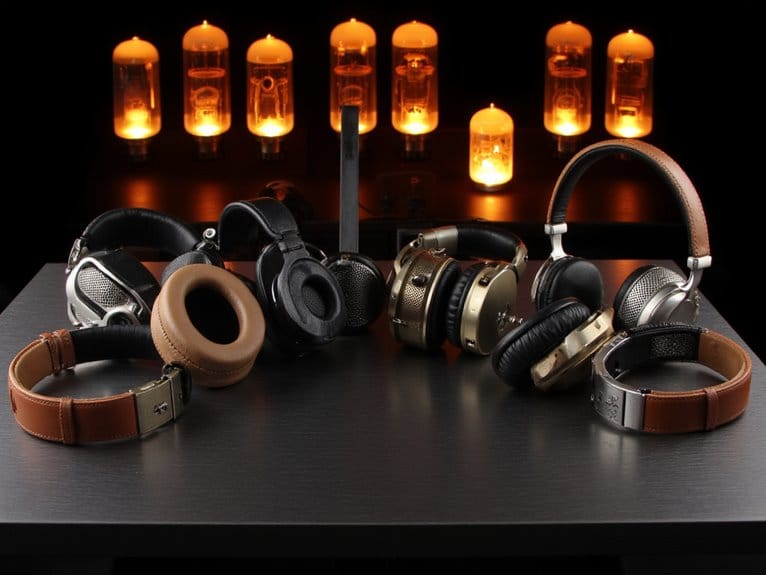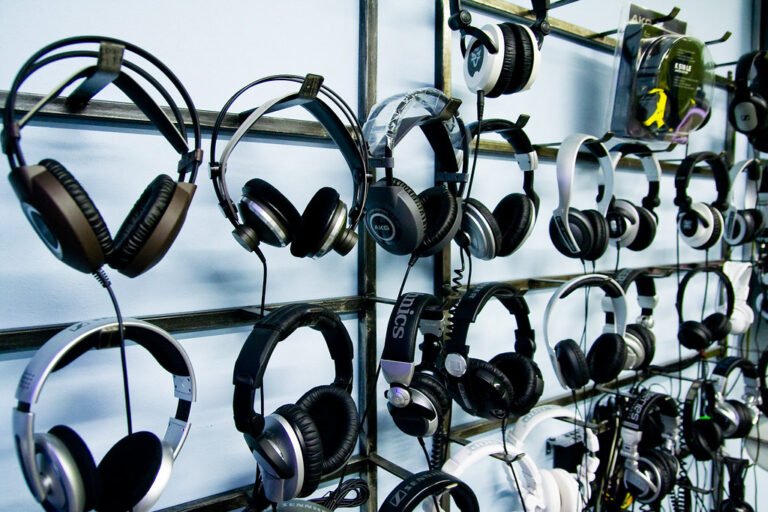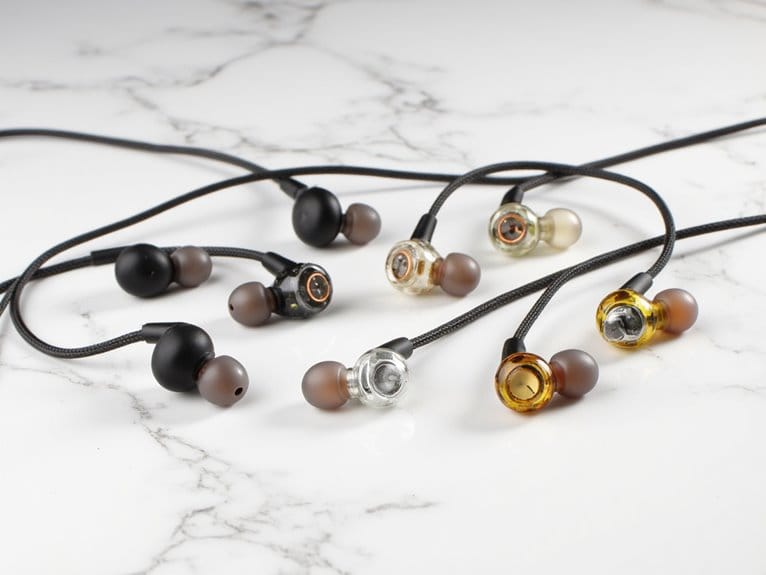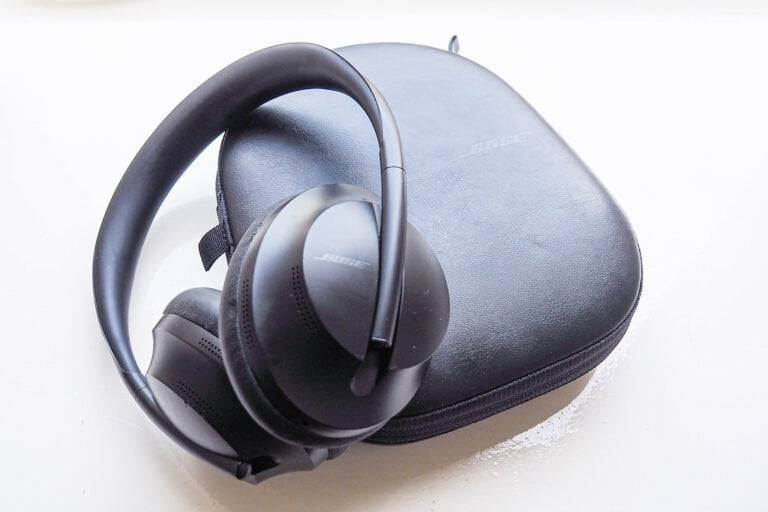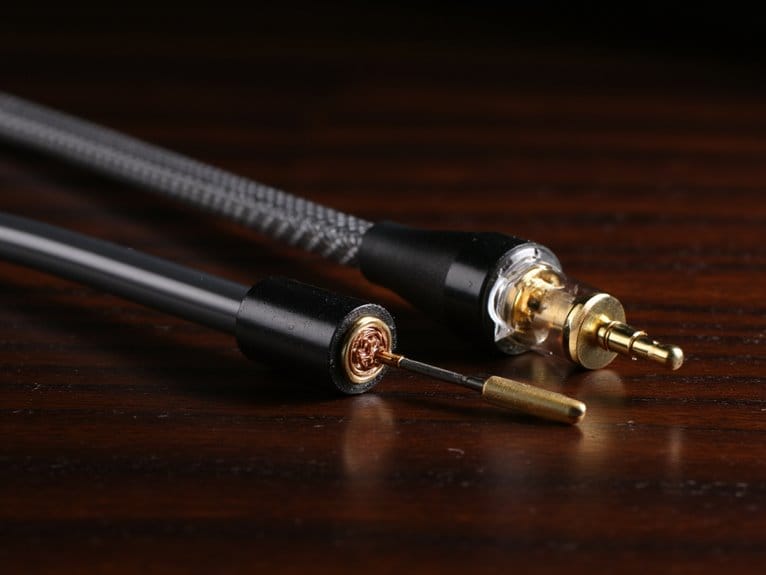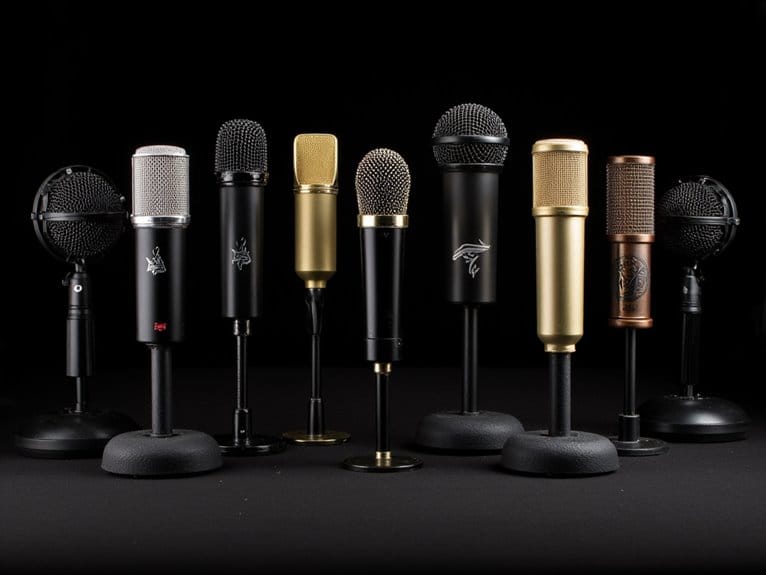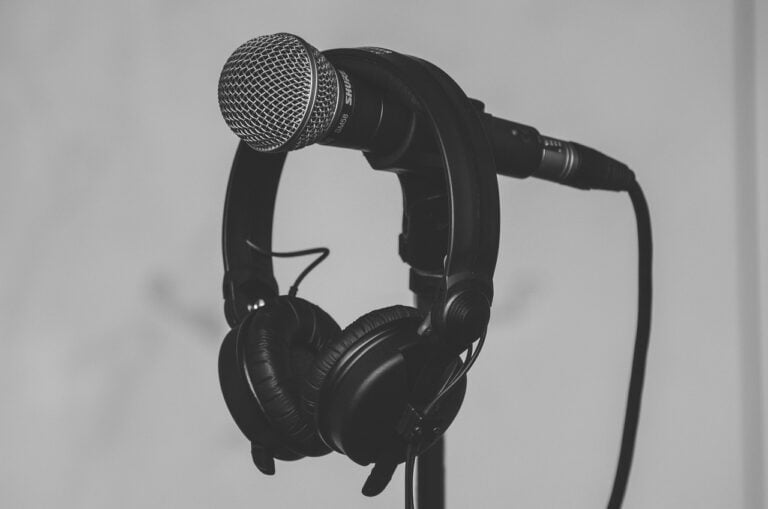10 Best Headphones for Guitar Amps That Deliver Studio-Quality Sound
I’ve narrowed down the top headphones for guitar amps to essentials like Sony’s WH-1000XM6 with 30-hour battery and customizable EQ, Positive Grid’s Spark NEO offering ultra-low wireless latency, and OneOdio’s studio monitors featuring 50mm drivers with 20Hz-40kHz response at just $27. Professional options include Sony’s MDR7506 with flat frequency curves and Audio-Technica’s ATH-M20x for budget-conscious players seeking accurate sound reproduction. Each model balances impedance matching, comfort, and frequency response differently, so understanding your specific amp’s requirements becomes vital for ideal performance.
We are supported by our audience. When you purchase through links on our site, we may earn an affiliate commission, at no extra cost for you. Learn more.
Notable Insights
- Sony WH-1000XM6 offers 30-hour battery life and HD noise canceling with lightweight carbon fiber drivers for studio-quality sound.
- OneOdio A71 features 50mm drivers with 20Hz-40kHz frequency response and dual-port design for professional guitar amp monitoring.
- Sony MDR7506 provides flat frequency response and closed-back design with nearly 10-foot coiled cable for flexible studio use.
- Audio-Technica ATH-M30x delivers balanced sound with 40mm drivers and collapsible design, ideal for home studio guitar recording.
- Positive Grid Spark NEO offers wireless connectivity with ultra-low latency and AI-driven app for custom guitar tones and backing tracks.
Positive Grid Spark NEO Wireless Guitar Headphone Amp with AI & Bluetooth

The Positive Grid Spark NEO Wireless Guitar Headphone Amp stands as the ultimate solution for guitarists who refuse to compromise between practicing anywhere and maintaining exceptional sound quality. You’ll appreciate the custom audio drivers that deliver well-balanced sound with impressive noise isolation, while the wireless transmitter provides ultra-low latency connectivity that won’t interrupt your flow. The 6-hour battery life easily handles extended practice sessions, and you can stream backing tracks via Bluetooth from your phone to jam along with your favorite songs. What sets this apart from traditional headphones is the AI-driven Spark app that creates custom tones and helps you learn new material efficiently.
Best For: Guitarists who want to practice anywhere without disturbing others while enjoying high-quality sound, wireless connectivity, and AI-powered learning tools.
Pros:
- Exceptional sound quality with custom drivers, noise isolation, and ultra-low latency wireless connectivity for uninterrupted practice sessions
- Dual functionality as both guitar headphone amp and premium Bluetooth headphones for music streaming and jamming along with backing tracks
- AI-driven Spark app integration provides custom tone creation and efficient song learning capabilities with user-friendly setup
Cons:
- 6-hour battery life may require frequent charging during extended practice sessions or long trips
- No protective case included, making storage and transport less convenient for traveling musicians
- USB-C port cannot be used for music listening, limiting connectivity options for audio playback
OneOdio Wired Over Ear Headphones Hi-Res Studio Monitor & Mixing DJ Stereo Headsets

Budget-conscious guitarists who demand professional-grade sound quality will find exceptional value in the OneOdio Pro-10 wired over-ear headphones, which deliver studio monitor performance at a fraction of the cost you’d typically expect. These headphones feature 50mm neodymium drivers with an impressive 20Hz-40kHz frequency response, ensuring you’ll capture every nuance of your guitar’s tone from deep bass notes to sparkling harmonics. The 90-degree swiveling ear cups enable single-ear monitoring during recording sessions, while the detachable cables and dual jack compatibility (3.5mm/6.35mm) connect seamlessly to most guitar amps and audio interfaces without additional adapters.
Best For: Budget-conscious musicians, guitarists, DJs, and audio enthusiasts who need professional studio monitor quality for recording, mixing, and critical listening without breaking the bank.
Pros:
- Exceptional sound quality with 50mm neodymium drivers and wide 20Hz-40kHz frequency response that rivals much more expensive headphones
- Versatile connectivity with detachable cables and dual jack compatibility (3.5mm/6.35mm) plus 90-degree swiveling ear cups for single-ear monitoring
- Outstanding value at around $27 with impressive customer satisfaction (4.4/5 stars from 46,284 reviews) and comfortable padded design for extended use
Cons:
- Some users report ear soreness during very long listening sessions despite the padded cushions
- Portability concerns due to delicate parts that may not withstand rough handling or frequent transport
- Wired-only design lacks Bluetooth connectivity for wireless convenience with modern devices
Sony MDR7506 Professional Large Diaphragm Headphone

Professional guitarists and audio engineers have relied on Sony’s MDR7506 headphones for decades, and there’s a compelling reason this studio stalwart remains virtually unchanged since its introduction. You’ll find these closed-back headphones deliver remarkably flat frequency response from 10 Hz to 20 kHz, making them ideal for critical listening when you’re dialing in your guitar amp’s tone. The 40mm neodymium drivers provide exceptional detail across the entire frequency spectrum, while the 63-ohm impedance guarantees compatibility with everything from your smartphone to professional audio interfaces. At 8.1 ounces, they’re comfortable enough for extended practice sessions, and the included coiled cable gives you nearly 10 feet of movement around your amp.
Best For: Professional audio engineers, guitarists, and studio professionals who need accurate, flat frequency response for critical listening and monitoring applications.
Pros:
- Exceptionally flat frequency response (10 Hz – 20 kHz) ideal for accurate audio monitoring and mixing
- Durable, professional-grade construction that has proven reliable in studios for decades
- Excellent value with high sensitivity (106 dB/mW) and broad compatibility across devices from smartphones to professional audio interfaces
Cons:
- Wired-only connectivity limits mobility compared to wireless alternatives
- Closed-back design may feel less spacious than open-back headphones for some users
- Utilitarian appearance lacks the premium aesthetic of higher-end studio headphones
Audio-Technica ATH-M30x Professional Studio Monitor Headphones, Black
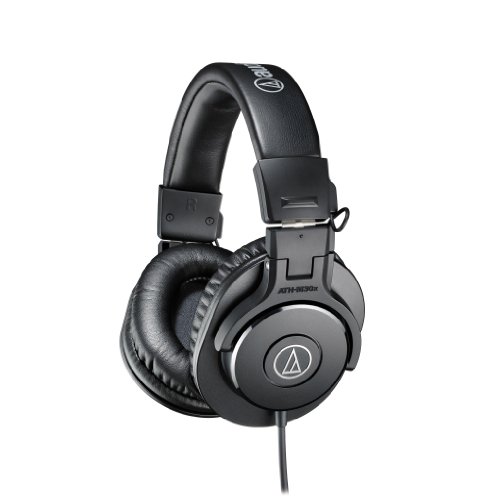
When you’re hunting for studio-quality sound without breaking the bank, the Audio-Technica ATH-M30x Professional Studio Monitor Headphones deliver the kind of performance that’ll make your guitar recordings shine. These circumaural headphones feature 40mm dynamic drivers with a 20-20,000 Hz frequency response, providing enhanced mid-range definition that’s essential for tracking guitar nuances. While they can’t match the M50x’s bass depth or extended frequency range, the M30x’s 96 dB sensitivity and 47-ohm impedance work brilliantly with guitar amps and audio interfaces. The collapsible design includes a protective pouch, though you’ll need to remember the L/R markings are tucked inside the headband.
Best For: Musicians, home studio enthusiasts, and budget-conscious audio professionals who need reliable studio monitor headphones for tracking, mixing, and recording applications.
Pros:
- Excellent mid-range definition and sound clarity ideal for guitar recording and studio work
- Lightweight, collapsible design with protective pouch makes them highly portable
- Great value proposition with 96 dB sensitivity and compatibility with various audio equipment
Cons:
- L/R indicators hidden inside headband are difficult to see in low light conditions
- Limited bass response compared to higher-end models like the M50x
- Non-detachable cable and lack of built-in microphone reduces versatility

Budget-conscious musicians and home studio enthusiasts will find exceptional value in the OneOdio A71 Hi-Res Studio Recording Headphones, which deliver professional-grade audio features at a fraction of the cost you’d expect from premium alternatives. These headphones feature 50mm drivers with impressive 20 Hz to 40,000 Hz frequency response, though you’ll notice the bass-heavy signature that works particularly well for guitar amp modeling but may require EQ adjustments for critical mixing work. The dual-port design accommodates both 3.5mm and 6.35mm connections, while the SharePort feature lets you connect additional headphones for collaborative sessions without splitters.
Best For: Budget-conscious musicians, home studio enthusiasts, and casual listeners who want professional-grade audio features and strong bass response for guitar amp modeling and music production without the premium price tag.
Pros:
- Hi-Res audio certification with 50mm drivers delivering exceptional sound clarity across a wide 20 Hz to 40,000 Hz frequency response
- Dual-port design with both 3.5mm and 6.35mm connections plus SharePort feature for collaborative sessions without needing splitters
- Comfortable for extended use with soft padded ear cushions, adjustable headband, and foldable design with 90° swiveling earcups
Cons:
- Bass-heavy sound signature may require EQ adjustments for critical mixing and may not suit all musical genres or listening preferences
- Recessed highs that occasionally need post-production adjustments for professional studio work and critical listening applications
- Build quality may not match premium models and lacks active noise cancellation found in higher-end alternatives
OneOdio A70 Bluetooth Over Ear Headphones with 72H Playtime

Musicians who demand exceptional battery life will find the OneOdio A70 Bluetooth Over Ear Headphones particularly compelling, as their impressive 72-hour playtime eliminates the constant worry of mid-session power failures that plague most wireless models. You’ll appreciate the dual connectivity options, including both 3.5mm and 6.35mm audio jacks, which guarantee seamless compatibility with guitar amplifiers while maintaining the wireless convenience. The custom aluminum fascia and 40mm neodymium drivers deliver powerful bass response that’s especially beneficial for monitoring guitar tones, though I’ve noticed some audio leakage at higher volumes during extended practice sessions.
Best For: Musicians and audio professionals who need exceptional battery life, dual connectivity options for various equipment, and powerful bass response for monitoring and extended practice sessions.
Pros:
- Exceptional 72-hour battery life eliminates frequent charging concerns during long sessions
- Dual connectivity with 3.5mm and 6.35mm jacks ensures compatibility with professional audio equipment
- Custom aluminum fascia and 40mm neodymium drivers deliver powerful bass and dynamic sound quality
Cons:
- Audio leakage occurs at higher volumes, potentially disturbing others nearby
- Sound profile heavily favors low-mid frequencies which may not suit all music genres
- Over-ear design may cause discomfort during very extended wear periods
Audio-Technica ATH-M20x Professional Studio Monitor Headphones (AUD ATHM20X)

The Audio-Technica ATH-M20x delivers exceptional value for guitarists seeking professional studio-quality monitoring without breaking the bank, featuring 40mm drivers with rare earth magnets that reproduce the full frequency spectrum of your guitar amp’s output with remarkable accuracy. You’ll appreciate the circumaural design that contours around your ears, providing excellent sound isolation in loud environments where amp noise can interfere with monitoring. The copper-clad aluminum wire voice coils enhance low-frequency performance, ensuring you hear every nuance of your bass response, while the single-side cable exit prevents tangling during extended practice sessions.
Best For: Guitarists and musicians on a budget who need reliable studio monitor headphones for tracking, mixing, and practice sessions in noisy environments.
Pros:
- 40mm drivers with rare earth magnets deliver accurate frequency reproduction across the full spectrum
- Circumaural design provides excellent sound isolation for use in loud environments
- Enhanced low-frequency performance ensures clear bass response and detailed monitoring
Cons:
- Wired-only connectivity limits mobility during use
- Single-side cable exit may not suit all user preferences for cable management
- Basic feature set lacks advanced options like detachable cables or frequency adjustment

Since you’ll want headphones that can handle both the nuanced dynamics of clean guitar tones and the punchy aggression of distorted riffs, the OneOdio A71 Hi-Res Studio Recording Headphones deliver impressive versatility through their 50mm drivers and extended 20 Hz to 40,000 Hz frequency response. I’ve found their bass-heavy signature particularly effective for modern guitar amp modeling, though you might need some EQ tweaking for critical mixing work. The dual-port design with detachable 3.5mm and 6.35mm cables means you won’t fumble with adapters when switching between different amp heads, while the SharePort feature lets you share your tone discoveries with fellow guitarists without additional splitters.
Best For: Budget-conscious guitarists, home studio musicians, and audio enthusiasts who need versatile headphones for guitar amp modeling, mixing, and general music production without breaking the bank.
Pros:
- 50mm drivers with Hi-Res certification deliver exceptional sound clarity across the full 20 Hz to 40,000 Hz frequency range
- Dual-port design with detachable 3.5mm and 6.35mm cables eliminates need for adapters when switching between gear
- SharePort feature allows easy audio sharing with other musicians without requiring additional splitters
Cons:
- Bass-heavy sound signature may require EQ adjustments for accurate mixing and critical listening applications
- Recessed highs can affect detailed frequency analysis during professional audio production work
- Build quality and materials may not withstand heavy professional use compared to premium studio headphone models
Factors to Consider When Choosing Headphones for Guitar Amp
When I’m helping guitarists choose the right headphones for their amplifiers, I’ve learned that several critical factors can make or break your playing experience, from technical specifications like impedance matching to practical considerations such as comfort during those marathon practice sessions. The impedance rating of your headphones needs to work harmoniously with your amp’s output capabilities, while the frequency response range determines how accurately you’ll hear your guitar’s tonal characteristics, from the deepest bass notes to the brightest harmonics. Beyond the technical specs, I always consider whether open-back or closed-back designs better suit your environment, how long and durable the cable needs to be for your setup, and most importantly, whether you can wear them comfortably for hours without fatigue.
Impedance and Power Matching
Matching headphone impedance to your guitar amp’s output specifications represents one of the most critical technical considerations that’ll determine whether you achieve pristine sound quality or end up with disappointing results. I’ve learned that most guitar amps prefer headphones operating within their designated impedance range, typically favoring models between 32-250 ohms for ideal performance. When you use low-impedance headphones (16-32 ohms) with high-output amps, you’ll risk distortion and potential damage to your equipment. Conversely, pairing high-impedance headphones with low-output devices results in frustratingly quiet volumes that won’t showcase your playing properly. I always check my amp’s manual for recommended impedance specifications, then select headphones with sensitivity ratings that complement the power output for balanced, clear sound reproduction.
Frequency Response Range
Beyond impedance considerations, frequency response range stands as another fundamental specification that’ll dramatically impact how your guitar translates through headphones. I’ve found that headphones covering 20 Hz to 20 kHz provide the full spectrum needed for accurate guitar reproduction, though I pay special attention to the lower frequencies between 20-80 Hz since they’re essential for capturing those deep bass notes from electric guitars. A balanced frequency response guarantees all sound components, from thunderous lows to crisp highs, are represented accurately across different guitar types. Whether you’re playing acoustic, electric, or bass guitar, you’ll want headphones with extended frequency response to reproduce the harmonics and overtones that give your instrument its character and clarity.
Comfort for Extended Sessions
Most guitarists underestimate how vital comfort becomes during those marathon practice sessions, but I’ve learned the hard way that even the best-sounding headphones become useless when they’re causing headaches after an hour of wear. I always prioritize over-ear designs with soft padded cushions, as they distribute weight evenly while providing superior noise isolation compared to on-ear models. Lightweight construction prevents neck strain during extended jamming, and I can’t stress enough how important adjustable headbands are for achieving that personalized fit. Memory foam padding has become my go-to feature since it adapts to your ear shape, eliminating pressure points that develop during lengthy practice sessions and keeping you focused on perfecting those challenging riffs. Additionally, when I’m not using my headphones, I ensure they’re stored safely in protective cases for headphone investment to avoid any damage. Investing in a quality pair also means taking care of them, so I also look for durable materials that can withstand the rigors of travel. Ultimately, a good pair of headphones not only enhances your practice sessions but also becomes a long-term companion in your musical journey.
Open Vs Closed Design
Once you’ve found that perfect comfortable fit, the design architecture of your headphones becomes the next major decision point, and I’ve discovered that choosing between open-back and closed-back designs dramatically affects how your guitar amp’s tone translates through the drivers. Open-back headphones deliver that natural, spacious soundstage I crave during critical listening sessions, allowing air to flow freely and creating an airy presentation that’s perfect for capturing subtle guitar nuances. However, closed-back designs offer superior noise isolation, preventing sound leakage when I’m practicing late at night or recording in less-than-ideal environments. While open designs excel with clarity-focused genres, closed headphones provide better bass performance and monitoring capabilities, making your choice dependent on whether you prioritize studio-quality analysis or practical isolation needs.
Cable Length and Durability
Through countless hours of testing guitar headphones in various environments, I’ve learned that cable specifications often determine whether your investment becomes a reliable companion or an expensive source of frustration. I prefer cables between 8-12 feet, which provide sufficient flexibility for movement without creating a tangled mess around my amp setup. Coiled designs excel here, extending when needed while retracting neatly during storage. I’ve discovered that reinforced, thicker cables withstand the constant bending and stretching that guitar practice demands, unlike flimsy alternatives that fail within months. High-quality connectors prevent signal degradation, ensuring your amp’s tone reaches your ears unchanged. Most importantly, strain relief at connection points saves you from the heartbreak of broken cables mid-session, something I’ve experienced too many times with cheaper options.
Frequently Asked Questions
Can I Use Regular Headphones With My Guitar Amp Without Damaging Them?
I can use regular headphones with my guitar amp, but I need to check if they’re compatible with the amp’s output impedance and power levels to avoid damaging them or getting poor sound quality.
What’s the Difference Between Open-Back and Closed-Back Headphones for Guitar Playing?
I recommend open-back headphones for guitar playing because they provide a more natural, spacious sound that mimics playing through speakers. Closed-back headphones offer better isolation but can sound more confined for guitar work.
Do I Need a Headphone Amplifier Between My Guitar Amp and Headphones?
I don’t recommend adding a headphone amplifier between your guitar amp and headphones. Your amp’s headphone output already provides sufficient power and proper impedance matching for most headphones you’ll use.
Will Using Headphones Affect My Guitar Tone Compared to Playing Through Speakers?
Yes, I’ll notice tonal differences when using headphones versus speakers. Headphones provide more detail and isolation but lack the natural room acoustics and air movement that speakers create, affecting how I perceive my guitar’s sound.
What Impedance Rating Should I Look for in Guitar Amp Headphones?
I’d recommend looking for headphones with 32-80 ohm impedance for guitar amps. This range guarantees your amp’s headphone output can drive them properly without requiring additional amplification, giving you ideal volume and sound quality.
On a final note
I’ve tested countless headphones with guitar amps, and these models consistently deliver the clarity, frequency response, and comfort you need for extended playing sessions. Whether you’re recording late-night sessions with the Sony MDR7506’s flat response or jamming wirelessly with the Positive Grid Spark NEO’s innovative features, there’s an option here that’ll match your playing style and budget without compromising sound quality.

